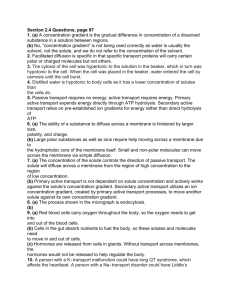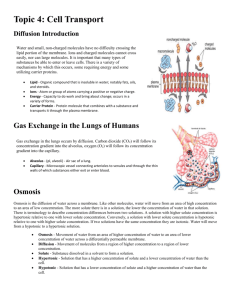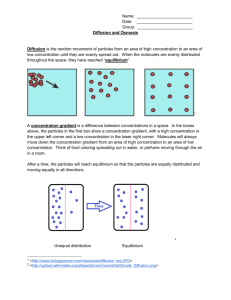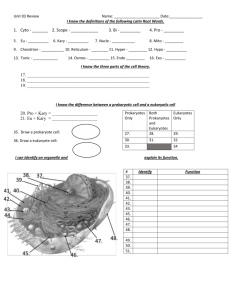osmosis problems from class
advertisement
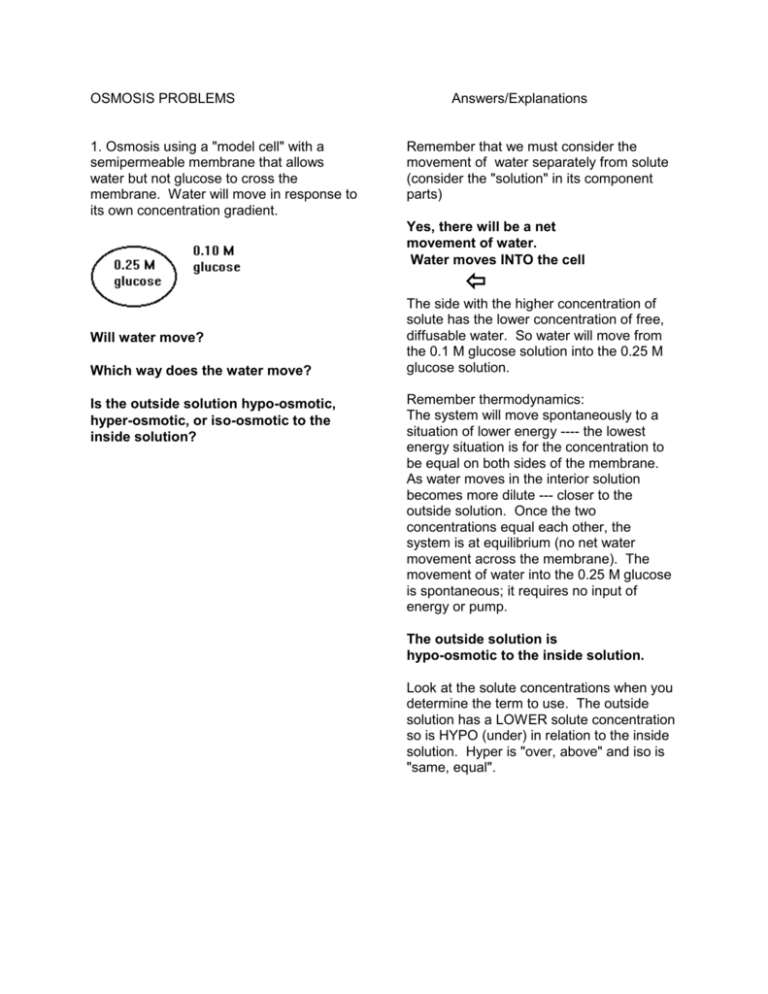
OSMOSIS PROBLEMS 1. Osmosis using a "model cell" with a semipermeable membrane that allows water but not glucose to cross the membrane. Water will move in response to its own concentration gradient. Answers/Explanations Remember that we must consider the movement of water separately from solute (consider the "solution" in its component parts) Yes, there will be a net movement of water. Water moves INTO the cell Will water move? Which way does the water move? Is the outside solution hypo-osmotic, hyper-osmotic, or iso-osmotic to the inside solution? The side with the higher concentration of solute has the lower concentration of free, diffusable water. So water will move from the 0.1 M glucose solution into the 0.25 M glucose solution. Remember thermodynamics: The system will move spontaneously to a situation of lower energy ---- the lowest energy situation is for the concentration to be equal on both sides of the membrane. As water moves in the interior solution becomes more dilute --- closer to the outside solution. Once the two concentrations equal each other, the system is at equilibrium (no net water movement across the membrane). The movement of water into the 0.25 M glucose is spontaneous; it requires no input of energy or pump. The outside solution is hypo-osmotic to the inside solution. Look at the solute concentrations when you determine the term to use. The outside solution has a LOWER solute concentration so is HYPO (under) in relation to the inside solution. Hyper is "over, above" and iso is "same, equal". PROBLEM/QUESTIONS ANSWERS/EXPLANATION 2. Osmosis situation with two different solutes, requiring some unit conversion. The semi-permeable membrane in this example will not allow sugars to pass. No, the type of solute does not matter. Only the total solute concentration is important in determining which way water will move (water is the only molecule that is moving across the membrane). Water moves INTO the cell Does it matter which solute is on each side when considering osmosis? Which way will the water move? Is the outside solution hypo-osmotic, hyper-osmotic, or iso-osmotic to the inside solution? ------------------------------------------------------3. Osmosis problem in which at least one of the solutes dissociates in water. The semi-permeable membrane in this example will not allow salt ions or sugars to pass across. into the 25 mM glucose solution, which has a higher solute concentration than the 10 m sucrose. 10 m = 0.010 mM (micro is smaller than milli by a factor of 1000) 25 mM >> 0.010 mM 25,000 uM >> 10 uM The outside solution is hypo-osmotic with respect to the inside solution. It is also called hypotonic, because the cell will swell in response to it. --------------------------------------------------------- NaCl Na+ + ClEach mole of NaCl dissociates into one mole of Na+ and one mole of Cl- , so there are 2 moles of solute entities per mole of NaCl dissolved. 0.5 M NaCl has the osmotic strength of a 0.5 M x 2 = 1.0 M solution. Which way will the water move? Is the outside solution hypo-osmotic, hyper-osmotic, or iso-osmotic to the inside solution? Is the outside solution hypotonic, hypertonic, or isotonic? Each ion interacts with water -- each has a "hydration shell", so each effectively decreases the concentration of free, diffusable water molecules. INSIDE SOLUTE CONC = 1.0 M OUTSIDE SOLUTE CONC = 1.0 M Water will have no net movement. The outside solution is iso-osmotic to the inside solution. The outside solution is isotonic because the cell will not shrink or swell. QUESTIONS 4. Osmosis problem in which there is more than one solute in the inside and/or outside solution. The semi-permeable membrane will not allow the passage of salts, ions, or sugar solutes. ANSWERS/EXPLANATION Only total solute concetration is important for predicting osmosis. If more than one type of solute is present, ADD UP THE CONCENTRATIONS OF ALL SOLUTES TO GET A TOTAL. INSIDE: 0.1 M x 2 = 0.2 M (dissociates to 2 ions) 0.2 M x 3 = 0.6 M (dissociates to 3 ions) -----------------------0.8 M total Which way will the water move? Is the outside solution hypo-osmotic, hyper-osmotic, or iso-osmotic to the inside solution? Is the outside solution hypotonic, hypertonic, or isotonic? ---------------------------------------------------------------- 5. Diffusion of a solute across the membrane. This schematic shows a dark line representing a lipid bilayer membrane. Urea can cross this membrane by simple diffusion. Consider only urea movement. Will urea diffuse across without any input of energy (i.e. spontaneously)? OUTSIDE 0.1 M (glucoes does not dissociate) 0.2 M (sucrose does NOT hydrolyze to --------- component monosaccharides 0.3 M without an enzyme! ) inside 0.6 M > outside 0.3 M Water moves INTO the cell The outside solution is hypo-osmotic to the inside solution. The outside solution is considered hypotonic because the cell swells in it. ---------------------------------------------------------Each solute that can do so will diffuse across the membrane in response to its own concentration gradient (remember, the lowest energy situtation is for the urea concentration to be equal on both sides). Urea molecules will move from 0.25 M urea into the 0.1 M urea solution (net movement to right). This is a spontaneous process, not requiring energy input. The movement is passive, not active. QUESTIONS ANSWERS/EXPLANATION 6. Diffusion of a solute across the membrane when other solutes are present. This schematic shows a dark line representing a lipid bilayer membrane. Urea and glycerol can cross this membrane by simple diffusion. Each solute that can do so will diffuse across the membrane in response to its own concentration gradient (remember, the lowest energy situtation is for that solute to be equal in concentration on both sides). Each moves from higher (0.25 M) to lower (0.1 M ) concentration. 0.25M 0.25M 0.1M Glycerol moves to the left 0.1M Which way will urea diffuse? Urea moves to the right Which way will glycerol diffuse? ---------------------------------------------------7. Osmosis and diffusion both need to be considered when figuring out whether a cell will burst or not when dropped in a solution. Here, urea but not sucrose can diffuse across the lipid bilayer. When the cell is dropped in this urea solution, is the outside solution hypo-, hyper- or iso-osmotic to the inside solution? Will sucrose move? Will urea move? ------------------------------------------------All of these solutions we are talking about are aqueous. This means that they are composed of solute molecules dissolved in water. We need to consider the movement of each type of molecule separately in making our predictions. TOTAL SOLUTE AT START CONDITIONS: INSIDE = 0.25 M OUTSIDE = 0.25 M The outside solution is iso-osmotic to the inside solution. No net water movement predicted for this start situtation. Will sucrose move? No, it cannot penetrate the lipid bilayer. Will urea move? Yes, It will move from 0.25 M urea side INTO THE CELL (urea conc is 0 M inside). If follows its own concentration gradient. What happens to the cell? Which -tonic term do we use? NOW, as urea moves in there is more total solute inside the cell then outside. The outside solution is now hypo-osmotic, water moves in and the cell swells. The 0.25 M urea is therefore HYPOTONIC for this 0.25 M sucrose cell.



